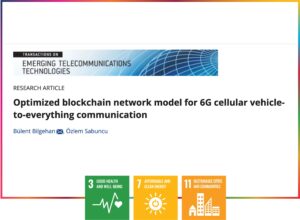
Research conducted by researchers Bilgehan and Sabuncu from Department of Electrical and Electronic Engineering, Near East University has delved into the critical realm of road safety for electric cars, particularly focusing on the necessity for swift and robust data transmission. In this era of technological advancement, the emergence of sixth-generation (6G) networks presents a promising solution, offering hyper-speed, ultra-reliable connectivity with minimal latency.
The study emphasizes the pivotal role of data reliability, a requirement met through the utilization of blockchain technology, renowned for its decentralized data management capabilities. By leveraging an optimized path based on signal-to-noise constraints, the researchers have devised algorithms tailored to ensure error-free transmission of high-speed, large data volumes.
The proposed approach entails a three-stage implementation strategy. Firstly, edge computers stationed at various points serve as storage hubs, resolving initial data management challenges. Secondly, a C-V2X network solution addresses economic activity, enhancing connectivity and efficiency. Finally, a two-stage optimization strategy optimizes network transaction levels, further streamlining data transmission processes.
Simulation results juxtaposed against traditional calculation methods underscore the efficacy of the newly introduced algorithms. Real-time experimental data, including signal-to-noise ratio (SNR) and bit error rate (BER) values, corroborate the success of the proposed methodologies.
While blockchain networks offer secure transactions, storage limitations necessitate the integration of edge computing support. By processing and storing transactions at edge computers, data management complexities are mitigated, culminating in maximum transfer rates and channel efficiency.
Notably, the selection of the Signal-to-Interference-plus-Noise Ratio (SINR) value plays a pivotal role in optimizing communication links, thereby minimizing transmission errors at minimal cost. The introduced optimization methods, simulated using realistic parameters, exhibit promising performance outcomes, validated through SNR and BER analysis.
The research from Near East University pioneers innovative approaches to enhance road safety for electric vehicles through optimized data transmission protocols. By leveraging cutting-edge technologies and strategic methodologies, the study sets a precedent for future advancements in the field, with practical implications for real-world applications.
More Information:
https://onlinelibrary.wiley.com/doi/full/10.1002/ett.4868